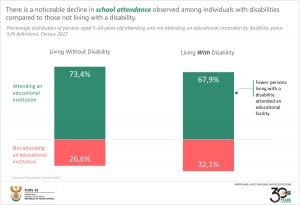Prevalence of disability on the decline in SA
In 2022, South Africa had a population of 62 million persons, with around 3,3 million individuals identified as living with disabilities.
A recent report from Statistics South Africa, titled “Profiling Socio-economic Status and Living Arrangements of Persons with Disabilities in South Africa, 2011–2022,” revealed that disability prevalence varied across different measures. The findings, which are based on three disability assessment models: the Broad1, the United Nations (UN), and Severe measures, indicated a prevalence of 15,7% for broad disability, 6,0% according to the United Nations measure, and 3,4% for the severe measure. Interestingly, between Census 2011 and 2022, disability prevalence decreased across all three measures.
Based on the findings, a vast majority, 90,0% and higher, of South Africans encountered no functional difficulties across all domains2 such as vision, hearing, verbal communication, mobility, memory/concentration, and self-care. However, these results exclude persons in institutions, which primarily house most of the persons living with a disability. Notably, the prevalence of disability was higher among older individuals, suggesting that advancing age correlates with increased functional challenges. This trend was consistent across both census periods, indicating a rise in disability prevalence with advancing age.
From 2011 to 2022, the age breakdown revealed a significant decrease in the prevalence of disabilities among children aged 5 to 9 years and a corresponding increase among older individuals aged 80 years and above. During this period, disability inquiries were directed solely to individuals aged 5 years and older, whereas in 2011 all household members, regardless of age, were asked these questions.
Regarding gender disparities, females consistently exhibited the highest disability prevalence across all three disability measures. Similarly, within the population groups, the white demographic exhibited the highest disability prevalence across all three measures.
When looking at the socioeconomic status of individuals living with disabilities, the impact of disability-based discrimination over past decades is unveiled and is particularly evident around education. The results underscore the historical marginalisation and exclusion experienced by persons living with disabilities, hindering their access to educational opportunities on par with their counterparts who are living without disabilities. Disparities in disability status further highlight the disparities in educational attainment, with a noticeable decline in school attendance observed among individuals living with disabilities compared with an opposite trend among those without disabilities, thus reaffirming the persistent inequalities between these two groups.
Analysis of living arrangements utilising the three disability measures yielded consistent outcomes. The majority of individuals were found to reside in extended households, followed by those in nuclear households, across all three disability measures—a pattern mirroring the broader landscape of South African households. Specifically, the majority of the Black African and Coloured population lived in extended households, while the Indian/Asian and White population groups tended to inhabit nuclear households.
Regarding assistive device usage, a predominance of usage was observed among older individuals, with usage generally increasing with age. Gender disparities revealed that females exhibited a higher proportion of usage across various assistive devices such as eyeglasses, walking sticks/frames or crutches, and wheelchairs compared to males. The white population groups exhibited higher rates of usage across all four assistive devices compared to other population groups.
An in-depth analysis aimed at identifying factors associated with assistive device usage unveiled several significant associations. Usage was found to be correlated with age, gender, population group, level of education, and geographical location (except for walking sticks and prostheses in the City of Cape Town). Moreover, usage varied across population groups, with Whites and Indian/Asian individuals more likely to utilise assistive devices compared to Black Africans. Furthermore, the findings highlighted a relationship between the level of education and assistive device usage, indicating that individuals with formal education were more inclined to use such devices compared to those with no schooling.
The socio-economic status and living arrangements of persons living with disabilities are shaped by a complex interplay of societal, economic, and individual factors. Addressing these challenges requires a comprehensive approach that addresses barriers to employment, housing, education, and healthcare while promoting inclusivity, accessibility, and social justice for all members of society. Only through concerted efforts can we build a world where persons living with disabilities are valued, empowered, and able to fully participate in all aspects of life.
For more information download the full report here.
1Broad- The Broad measure encompasses individuals aged 5 years and above who indicated experiencing “some difficulty,” “a lot of difficulty,” or being unable to perform any of the six functional domains. The UN disability index comprises individuals aged 5 years and older who reported experiencing “a lot of difficulty” or being unable to perform any of the six functional domains. The Moderate to Severe disability measure includes individuals aged 5 years and older who reported experiencing some difficulty in at least two domains, or “a lot of difficulty,” or being unable to perform at least one of the six functional domains.
2Domains- The report was compiled to provide an overview on trends and patterns of disability prevalence in South Africa based on three measures derived from a continuum of levels of difficulty in functioning for six domains of functioning (seeing, hearing, communicating, walking /climbing a flight of stairs, remembering/concentrating and self-care)


